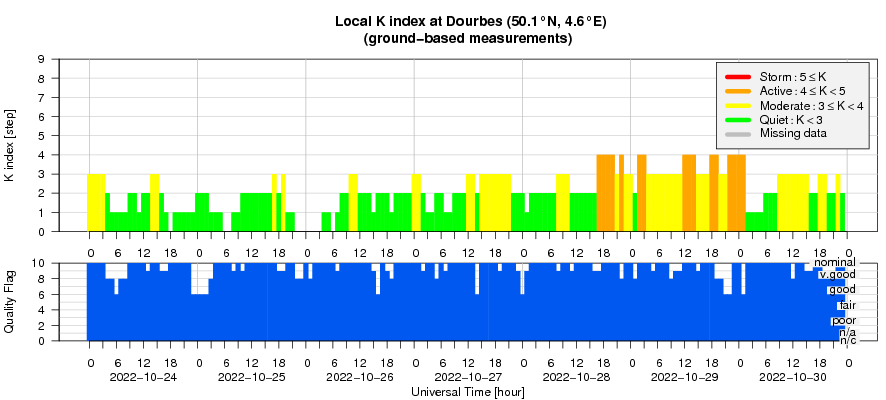- Table of Content
- 1.Topical Issue ...
- 2.When the sun v...
- 3.Review of sola...
- 4.Review of geom...
- 5.The Internatio...
- 6.Geomagnetic Ob...
- 7.The SIDC Space...
- 8.Action!
2. When the sun vanishes
3. Review of solar activity
4. Review of geomagnetic activity
5. The International Sunspot Index by SILSO
6. Geomagnetic Observations at Dourbes (24 Oct 2022 - 30 Oct 2022)
7. The SIDC Space Weather Briefing
8. Action!
Topical Issue on "Space Climate" for JSWSC
The Journal of Space Weather and Space Climate (JSWSC - https://www.swsc-journal.org/) opens a Topical Issue "Space Climate: Long-term effects of solar variability on the Earth's environment", to appear in 2023.
This Topical Issue (TI) has been initiated at the Space Climate 8 Symposium (https://spaceclimate8.uph.edu.pl/ ) held in Krakow (Poland) in late September 2022. However, the TI is not restricted to papers presented during the Symposium and is open to all submissions addressing the questions listed below.
This TI invites all contributions aiming at understanding long-term variability of solar activity and its effects on the heliosphere, the Earth's space environment, atmosphere and climate. This, in particular, includes the following research questions:
- What are the causes, manifestations and effects of long-term variations in solar activity?
- How do variations in solar activity, whether continuous or transient, affect the Earth’s space environment, atmosphere and climate system on timescales up to millennia?
- What are the intricacies in the different datasets used to make inferences about long-term solar variations, like the sunspot number time series and geomagnetic observations?
We welcome all manuscripts considering these aspects of Space Climate. The manuscripts must be submitted via the JSWSC online submission tool (https://www.editorialmanager.com/jswsc/ ). Guidelines for the submission of papers and information about article processing charges (https://www.edpsciences.org/en/publication-charges#swsc ) can be found on the JSWSC website under the tab "Instructions for Authors" (https://www.swsc-journal.org/author-information/instructions-for-authors ).
Deadline (submitting papers via the JSWSC online submission tool): 31 May 2023
All manuscripts will be peer-reviewed according to the quality standards of international scientific journals. The type of contributions must fit the style of JSWSC. All manuscripts should contain enough new insights, present the results against a properly referenced background of existing work, and present adequate evidence that supports the conclusions. Papers will be published immediately upon acceptance, without waiting for the TI closure, in electronic format only, and will be freely available to everyone via the JSWSC website. JSWSC offers the possibility to include electronic material, such as animations, movies, codes and data.
Topical Editor-in-Chief (T-EiC):
Agnieszka Gil (agnieszka.gil-swiderska@uph.edu.pl) Siedlce University of Natural Sciences and Humanities and Space Research Centre PAS, Poland
Topical Editors (TE):
Timo Asikainen (timo.asikainen@oulu.fi) University of Oulu, Finland
Nat Gopalswamy (natchimuthuk.gopalswamy-1@nasa.gov) NASA Goddard Space Flight Center, USA
Miriam Sinnhuber (miriam.sinnhuber@kit.edu) Karlsruhe Institute of Technology, Germany
For questions regarding this Topical Issue, please, contact the T-EiC. For questions concerning the submission process, please contact the Editorial Office (jswsc@edpsciences.org).
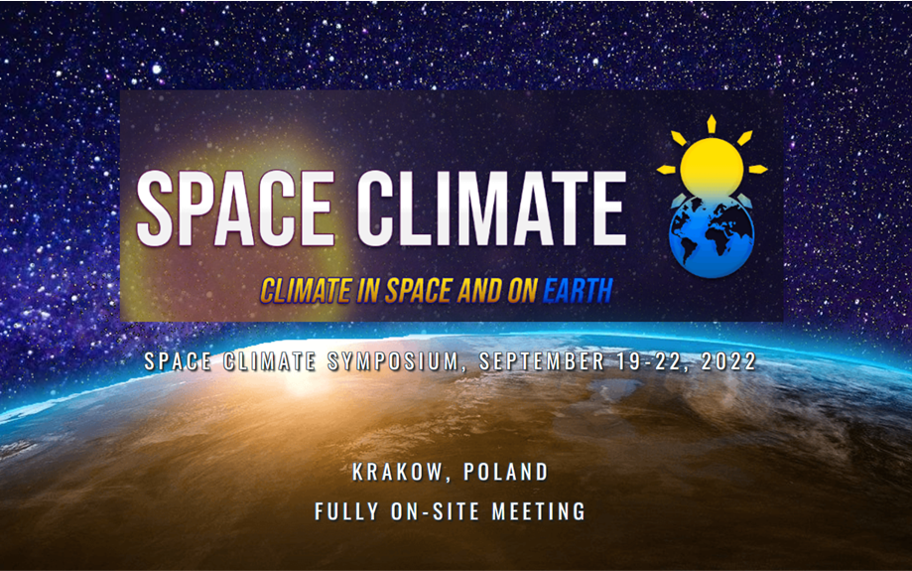
When the sun vanishes
A solar eclipse is an impressive and breathtaking event in the sky. It might be even scary. In early times, humans thought that gods or mystic creatures made the sun disappear. Until one found out that it was a perfect sized moon on her monthly trip around the earth that blocked the sun and forced the day to temporarily exchange with the night.
When the moon eclipses the sun completely, you get an extraordinary glimpse of the surroundings of the sun, revealing some solar secrets and science.
On 25 October 2022, a partial solar eclipse took place. Reason to organise a public talk at the European Space Weather Week 2022.
Enjoy a tour on solar eclipses and feel the suspense of CSI, Coronal Science Investigation: https://youtu.be/Ob0dtYwytsE
or https://www.stce.be/movies/20221025_solareclipse_zagreb.m4v
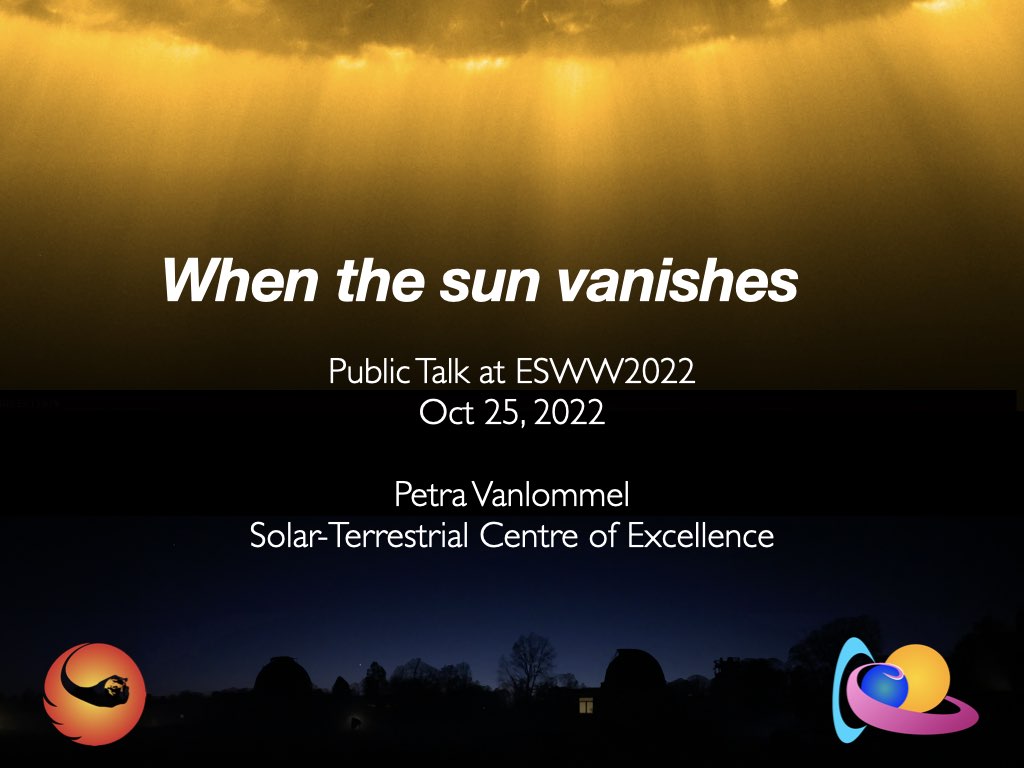
Review of solar activity
Flares
Solar flaring activity was at low levels, with 21 C-class flares and the brightest flare being a C9 at 27 Oct 06:44 UT from NOAA Active Region (AR) 3130 (Catania group 72, magnetic type Beta). The C-class flares were produced by NOAA Active Regions (AR) 3126 (Catania group 68, magnetic type Beta), 3130 (Catania group 72, magnetic type Beta), 3133 (Catania group 76, magnetic type Beta), 3135 (magnetic type Beta), and NOAA plage 3134.
Solar wind disturbances: Coronal Mass Ejections
Two partial halo coronal mass ejections that were closely located in time and space were observed over the course of the week. They were both back-sided and did not have an effect on Earth.
Solar wind disturbances: coronal holes
Three small corona holes (CH) with positive polarity crossed the central meridian during last week. The first was a northern CH that started crossing the central meridian on 24 Oct, the second was an equatorial CH that crossed on 26 Oct and the last was a northern CH that started crossing on the 28 Oct.
Solar Energetic Particles
The greater than 10 MeV proton flux was at nominal levels. The greater than 2 MeV electron flux exceeded the 1000 pfu threshold on 30 Oct 12:00 UT and remained above this level until the end of the week. Following the increase in electron flux, the 24h electron fluence reached moderate levels on 30 Oct 14:00 UT and remained at those levels for the rest of the week.
Review of geomagnetic activity
The Earth was under the waning influence of a positive polarity High-Speed Stream (HSS) at the start of the week, with a Solar Wind (SW) speed decreasing from around 550 km/s at the first half of 24 Oct to a low of 350 km/s at the second half of 26 Oct.
At noon of 28 Oct a HSS arrived, as expected, that affected the SW conditions with a speed that reached a maximum value of 600 km/s. Earth remained under the influence of the HSS until the end of the week.
The total magnetic field (Bt), fluctuating between 1 and 12 nT, while its north-south component (Bz) varied between -11 and 11 nT during the week. The interplanetary magnetic field (phi) angle was mostly negative (directed towards the Sun) during the first half of the week and became mostly positive from 27 Oct onwards.
Geomagnetic conditions were quiet until 29 Oct, when they reached minor storm levels (NOAA Kp 5) due to the arrival of a HSS. They returned to quiet levels on 30 Oct and remained so for the rest of the week.
The International Sunspot Index by SILSO
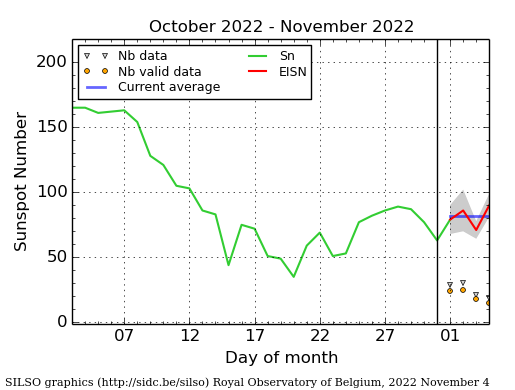
The daily Estimated International Sunspot Number (EISN, red curve with shaded error) derived by a simplified method from real-time data from the worldwide SILSO network. It extends the official Sunspot Number from the full processing of the preceding month (green line), a few days more than one solar rotation. The horizontal blue line shows the current monthly average. The yellow dots give the number of stations that provided valid data. Valid data are used to calculate the EISN. The triangle gives the number of stations providing data.
The SIDC Space Weather Briefing
The Space Weather Briefing presented by the forecaster on duty from Oct 23 to 30 2022. It reflects in images and graphs what is written in the Solar and Geomagnetic Activity report: https://www.stce.be/briefings/20221031_SWbriefing.pdf
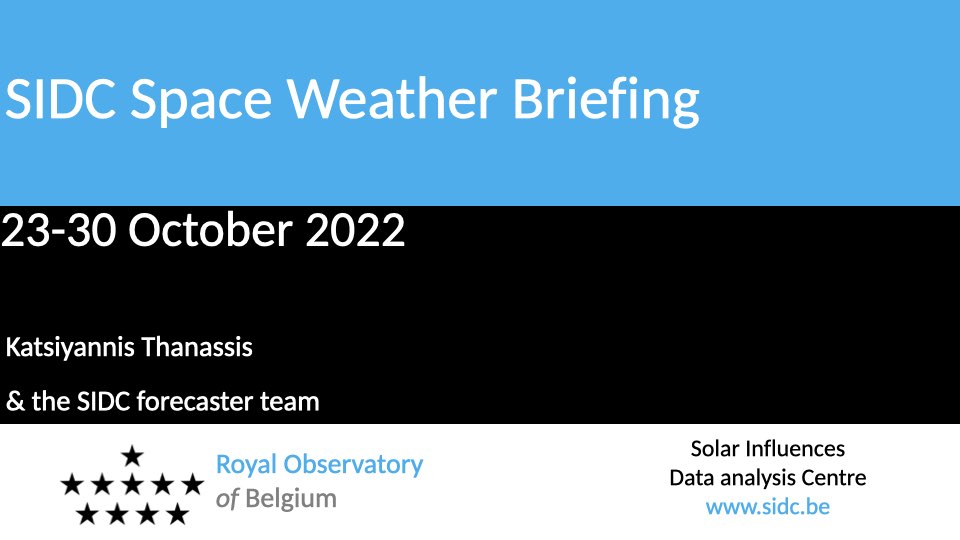
If you need to access the movies, contact us: stce_coordination at stce.be
Action!
Check out our activity calendar: activities and encounters with the Sun-Space-Earth system and Space Weather as the main theme. We provide occasions to get submerged in our world through educational, informative and instructive activities.
If you want your event in our calendar, contact us: stce_coordination at stce.be
* November 8, CmPA seminar: "From the pre-eruption state in the Sun to the propagation of eruption products in the inner heliosphere and beyond: connecting some dots", onsite and online, CmPA
* November 21-23, Space Weather Introductory Course - onsite, by the STCE, Brussels, Belgium - fully booked
* November 22, seminar: Ionospheric Disturbances Detection by HF Doppler sounding, onsite and online, STCE
* November 27, Dag van de Wetenschap, Planetarium, Belgium
* December 5, 6, 8, 9, Space Weather Introductory Course - online, by the STCE, zoom - fully booked
Check: https://www.stce.be/calendar

